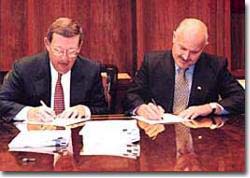The New Global Structure Of Exxon Mobil Corp.

 Exxon Mobil Corporation has launched its new worldwide global structure. The corporation will employ an organization structure built on a concept of 11 separate global businesses designed to allow the company to compete more effectively in a changing worldwide energy industry. Synergy benefits are expected to be higher than US2.8 billion annually. Lee Raymond, Chairman and Chief Executive Officer of the corporation, says that the company will soon announce a revised forecast of merger benefits that will likely exceed that figure.
Exxon Mobil Corporation has launched its new worldwide global structure. The corporation will employ an organization structure built on a concept of 11 separate global businesses designed to allow the company to compete more effectively in a changing worldwide energy industry. Synergy benefits are expected to be higher than US2.8 billion annually. Lee Raymond, Chairman and Chief Executive Officer of the corporation, says that the company will soon announce a revised forecast of merger benefits that will likely exceed that figure.
Regarding the synergy benefits the companies announced in December of 1998 Raymond said, "At that time, we announced an expectation that the near-term benefits would total $2.8 billion annually, on a pre-tax basis. Since that time, our business transition teams have done a lot more planning and analysis around how to combine the two companies and, at the same time, reorganize how we manage the business—with a clear goal of maximizing the company's overall performance. We are convinced that the combined company will achieve a higher return on capital than either company could have done alone.
"Much of what has been done since last December has, in effect, focused on maximizing synergy benefits. We now have a much better understanding of what we can achieve, how we can achieve it, and how much it could be worth. We have not yet, however, turned that understanding into an updated forecast. Our plan is to do some post-closing work—with an expectation that we will be able to announce a revised forecast of synergy benefits by mid-December."

Regarding the significant organizational work accomplished over the last year, Raymond noted that Exxon and Mobil have historically shared a number of core values that will continue to guide the management of ExxonMobil. "First and foremost, Exxon and Mobil shared a common resolve to maintain the highest standards for safety, health, and environmental care. The companies also shared a long-term commitment to creating shareholder value and a history of strong performance based on efficiency, capital productivity, and technological leadership," he said.
Transition Well Underway
Raymond noted that a significant amount of merger planning and transition work has already been completed.
"We started in the first quarter of 1999 with 150 people assigned to about 25 core transition teams. That number grew to more than 1,500 Exxon and Mobil people working on 140 teams just prior to closing. Throughout the process, the teams have functioned extremely well, with a high level of camaraderie and a common sense of purpose."
The ExxonMobil's corporate headquarters are officially up and running in Irving, TX. The Board of Directors has taken all the necessary actions to complete the merger and the company's new organizational structure. Financial reporting and cash handling processes are also in place, as are the company's emergency response and communication plans. Key policies and compensation and benefits programs are also in effect, primarily for US employees. In most other locations, the existing policies and programs will continue to apply until new ones are adopted by the local affiliates, which in some cases are subject to works council and labor agreements.
Each of the functional business line headquarters offices in Houston and Fairfax are in operation, and organizational plans have been developed for regional centers and other key office locations. These plans are being rapidly implemented, giving each functional company full readiness in managing their day-to-day business activities.
New Corporate Structure
ExxonMobil is employing a new organization structure built on a concept of 11 separate global businesses designed to allow the company to compete effectively in the worldwide energy industry. Five global upstream companies—Exploration, Development, Production, Gas Marketing, and Upstream Research—are to be headquartered in Houston, along with the chemical company and the coal and m inerals company. The remainder of the company will be based in Fairfax, Virginia.
The company's senior management, in addition to Raymond and Lou Noto, Vice Chairman of ExxonMobil and former CEO and Chairman of Mobil Corp., includes four senior vice presidents: Rene Dahan, Harry J. Longwell, Eugene A. Renna, and Robert E. Wilhelm. Dahan, Longwell, and Wilhelm were formerly senior vice presidents with Exxon Corporation. Renna was President and Chief Operating Officer of Mobil Corporation. The upstream companies will report to Longwell.
The ExxonMobil board of directors consists of 13 non-employee directors and six employee directors who are the members of the senior management team. Of the non-employee directors, nine were members of the Exxon board and four sat on the Mobil board.
Global Scope
ExxonMobil now has exploration or production operations in some 50 countries and a presence in nearly 200 countries.
"A key benefit of the merger is that it allows us to compete more effectively with the recently combined multinational oil companies and the very large state-owned oil companies that are rapidly expanding outside their home areas," Raymond said. "In addition," he added, "ExxonMobil will benefit as proprietary technology and customer offerings that were developed separately are shared and further improved."
In discussing the strategic fit of Exxon and Mobil, Raymond said the two companies align well with each other in almost every facet of the business. "In the exploration and production area, Mobil's and Exxon's respective strengths in Europe, Asia-Pacific, West Africa, the Caspian region, Russia, South America, and North America line up well, with minimal overlap. Our respective deepwater assets and deepwater technology also complement each other well."
